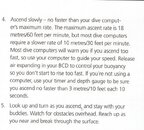My gf is getting certified through PADI and I looked over the Open Water Diver Manual and compared some of the teachings to SSI, the agency that I was certified with.
To my surprise, the PADI course is much more laid-back and less conservative in comparison to SSI. For example, the PADI manual rate of ascent is double SSI or 60ft/min. SSI is 30/min.
What the book says is in relation to the the RDP. The PADI RDP was tested with an 18m/min ascent rate and therefore the advice PADI gives in the version of the OW book that teaches tables is to not exceed that ascent rate. The book also points out that "slower is fine" although sadly they fail to define how much "slower" is ok, and what the general "best practice" is at this point in time.
IN ADDITION....
Not everyone dives with the tables. If you learn to dive with a computer then the PADI materials that teach you to dive with computer will tell you:
a) read the user's manual for your computer carefully and follow the manufacturer's instructions.
b) ascend in accordance to the manufacturer's advice, which in most cases conforms to the industry best practice of 10m/min.
In other words, what I'm trying to say here is that PADI's advice is relevant and specific to the tools the diver is being taught to use. Different books have different advice. SSI, if I'm reading you correctly, just provides a "one size fits all" answer, which happens to be a perfectly ok approach since it works.
I wouldn't say that one way or the other is more or less "conservative" or "laid back". In both cases, the information is correct and accurate. However, in the case of the PADI materials it is important for the student to be aware of the context in which it is being said. If I understand correctly, SSI avoids the context discussion by giving a general rule; PADI does not and therefore gives specific rules for each tool. Which way is better? Flip a coin. You'll be diving safely either way.
As for teaching it, I am a PADI instructor and when I teach OW I teach 18m/min as MAXIMUM and 10m/min as OPTIMAL when using the tables because I know it's the best practice throughout the industry and that the 10m/min ascent rate does not conflict with using tables. I also teach students various strategies for tightly controlling their ascent rate, which is something that isn't defined well in the book. This is the added value an instructor can have when teaching students how to translate theory (don't exceed a certain ascent rate) into practice (HOW to not exceed a certain ascent rate). Regardless of agency this is the reason you have an instructor and don't just learn diving by reading the book.
R..





